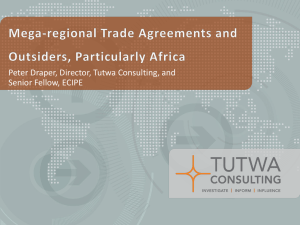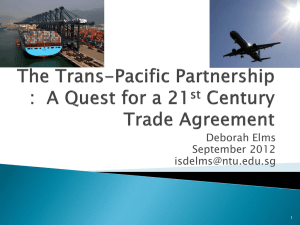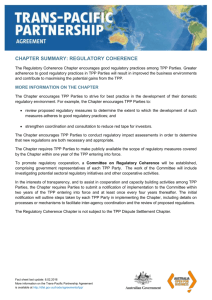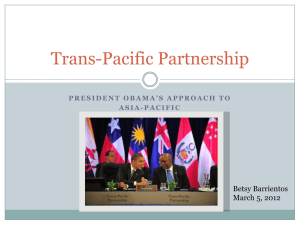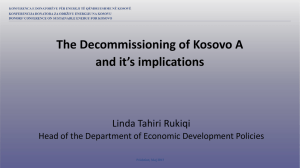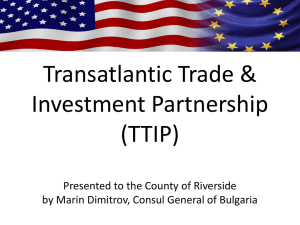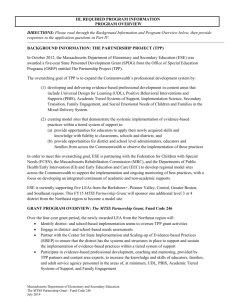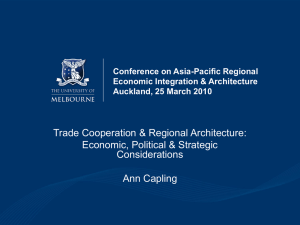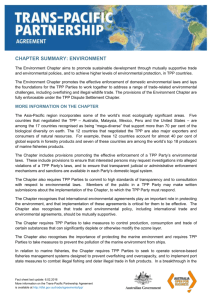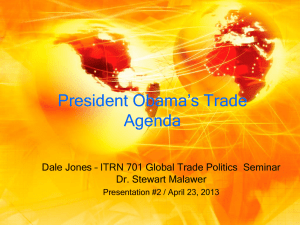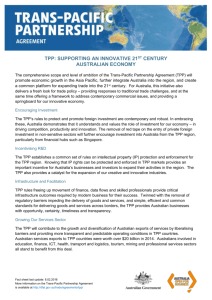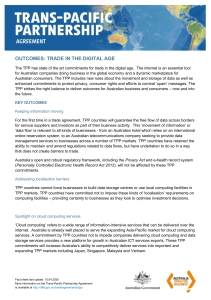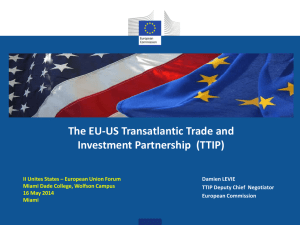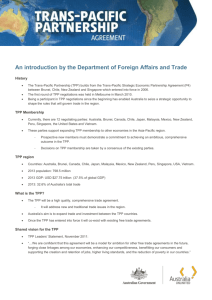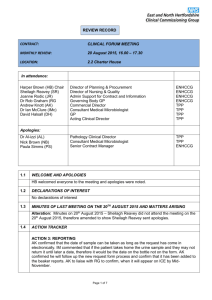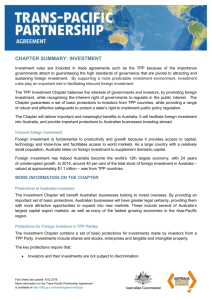External PTAs and the Indian Economy An Analysis of Impacts and
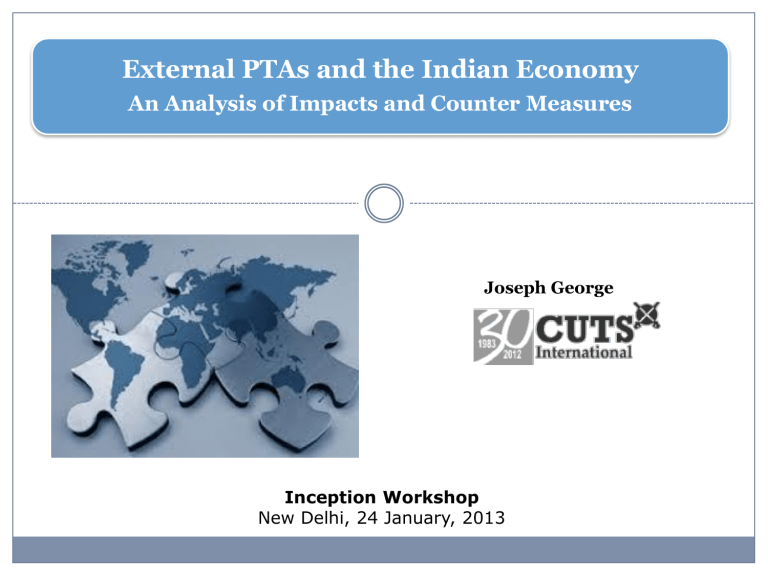
External PTAs and the Indian Economy
An Analysis of Impacts and Counter Measures
Joseph George
Inception Workshop
New Delhi, 24 January, 2013
Objectives of the Project
2
• Conduct extended analysis of diversion of trade (goods and services, exports and imports) and allied economic transactions (trade-related investments) from India vis-a-vis the participating countries in the EU-ASEAN FTA, the Trans-Pacific
Partnership agreement (TPP), and the Trans-Atlantic Trade and Investment Partnership agreement (TTIP).
• Conduct sectoral analysis of diversion of trade (goods and services, exports and
imports) and allied economic transactions (trade-related investments) from
India and impacts thereof on labour intensive and small scale sectors so as to assess the effects on poverty so as to frame appropriate policy responses to preempt negative impacts on poverty reduction.
• Conduct research- and evidence-based awareness generation and policy advocacy among the key Indian stakeholders
TPP
AUSTRALIA**
CANADA**
CHILE
JAPAN
MEXICO
N. ZEALAND**
PERU
Profile of Mega External PTAs
BRUNEI
MALAYSIA
SINGAPORE
VIETNAM
US
MYANMAR
CAMBODIA
INDONESIA
LAOS
PHILIPPINES
THAILAND
EU*
EU-ASEAN FTA
TTIP
Notes : European Union (EU) consists of 28 countries including Croatia, which has recently joined EU (in July 2013); TPP contains 12 countries,
TTIP has 29 countries and EU-ASEAN has 38 countries (EU 28 and ASEAN 10). Countries without formal trade agreements with India given in red.
* FTA under negotiations. ** CECA under negotiation.
External PTA
TPP
TTIP
EU-ASEAN
ALL
% Share in
World GDP
38.42
45.09
26.35
63.74
% Share of
Exports in World
Trade
31.4
40.28
38.72
58.66
% Share of
Imports in World
Trade
39.86
44.42
38.42
62.96
Intra-Regional
Trade in Group
26.79
37.17
41.11
49.27
%Share of
India's Imports
18.98
24.65
27.46
41.85
%Share of
India's
Exports
23.03
31.27
27.78
44.72
Framework for Analysis
A
B
4
Part 1. Trade in Goods Scenario
Sectoral Analysis
Sector specific threats facing sensitive sectors and sector specific policy remedies
Impact of new additional rules and disciplines on India’s trade
C
D
Macro Impact
∑Si – Aggregate impact on Current
Account – Transmission to key macro variables
General Equilibrium Modelling for
Welfare Impacts
Part 2. Trade in Services and Investment
• Different economic forces driving trade in services and investment flows
• New disciplines governing services and investment flows
• Analysis within the ambit of available data
Part 1. Trade in Goods Scenario (A)
Trade in Goods: Sectoral Selection
5
Part 1. Trade in Goods Scenario (A)
Export of Goods: Scenario 1
6
No. of highly vulnerable product lines
79
% Share in Indian Exports 6.2
1,0
0,5 low 0,0 Complementarity with import basket of non TPP region
Average RCA in non TPP markets
0 >
-0,5
-1,0
-1,0
TPP
-0,5 0,0
Threat Quotient
0,5
• Low level of value added content in vulnerable product lines, but mostly labor intensive
• Likelihood of product differentiation beyond 6-digit level in non TPP markets is low
• Likelihood of income loss in alternative markets is low
1,0
Part 1. Trade in Goods Scenario (A)
Export of Goods: Scenario 2
7
No. of highly vulnerable product lines
129
% Share in Indian Exports 17.2
1,0
0,5
TTIP
Complementarity with import basket of non TTIP region
Average RCA in non TTIP markets low
0 <
0,0
-0,5
-1,0
-1,00 -0,50 0,00
Threat Quotient
0,50
• Relatively high level of value added content in vulnerable product lines
• Likelihood of product differentiation beyond 6-digit level in non TPP markets is high
• Likelihood of income loss in alternative markets is high
1,00
Part 1. Trade in Goods Scenario
Export of Goods: Scenario 3
8
No. of highly vulnerable product lines
102
% Share in Indian Exports 9.2
Complementarity with import basket of non TPP-
TTIP region
Average RCA in non TPP-
TTIP markets
Very low
-0.3 <
• Relatively high level of value added content in vulnerable product lines
• Likelihood of product differentiation beyond 6-digit level in non TPP markets is very high
• Likelihood of income loss in alternative markets is very high
Capacity
Part 1. Trade in Goods Scenario (A)
Export of Goods Scenario: Emerging Challenges
9
Complementarity Difficult to find markets for displaced products outside TPP-TTIP region as level of product sophistication varies significantly
Likelihood of increase in competition within markets of excluded countries
Price differences (high for TPP-TTIP bound goods) + Additional
NTB costs likely to get added together
Relatively high trade costs with non TPP-TTIP partners, weak NTB resolution mechanisms
Weak preferential trading arrangements with Non-TPP-TTIP partners. Large-scale southern cooperation, which would be required to ward of the shock that may get transmitted, not possible without safeguards that are sparsely negotiated in agreements with southern countries
National Foreign Trade Policy (2009-14) has limited coverage with trade promotion policy instruments over threatened products
Part 1. Trade in Goods Scenario (B)
• Environmental standards
- Comprehensive rules for of liberalization of trade in EGSs in TPP, move to bring rules on fisheries subsidies, regionalization of existing environmental commitments under FTAs (US – Chile; NZ-Singapore)
• Rules of Origin
- Likely impacts of narrow, product specific origin rules on sensitive sectors including textiles and dairy products (TPP set to follow narrow, strict cumulation, high threshold rules as in NAFTA, KORUS)
• Labour Standards
- Protectionist abuse of strict labour standards not likely in TPP due to political uncertainty
- The direction of chapter on labour standards in TTIP uncertain
- Even softer rules under mega PTAs may influence consumer preferences in member countries
- Specific case studies on labor-intensive sensitive sectors needed.
Part 2. Trade in Services and Investment
11
Parameters for Services Trade Diversion Analysis
• Each of the TPP member countries have about 5 preferential agreements on services on an average
• NAFTA type negative-listing approach proposed, takes into account post-GATS conceptalisation of services trade
• Strengthening of sector specific regulatory disciplines, expansion of coverage irrespective of modes, stress on horizontal commitments
• Capacity building provision for developing countries, additional provision on ease of payments and transfers
Parameters for Investment Diversion Analysis
• Additional investor protection clauses against arbitrary exploitation, losses against armed conflict, provisions for free transfer of payments and fullinsurance coverage
• Modern investment treaty arbitration, proposed investor-state dispute settlement mechanisms
Part 3. Counter Measures and Future Negotiations
Implications for India’s Trade Negotiations
12
• Domestic Preparedness: NFTP Strategies
• Treaty Shopping - Prospects of dominion shift of negotiating resources to bilaterals of wider coverage with large TPP member states (CECAs with
Australia, Canada and New Zealand)
• Prospects of changes in negotiating positions on outstanding issues in FTA with EU and CECA with ASEAN
Positions on outstanding issues with EU; multiple tax structure on wines, auto sector tariffs, Mode
3 imports of financial services, market access in IT services and tariff structure for generic drugs.
Investment protocols under India-ASEAN CECA after services chapter, trade related investment outflow to ASEAN, concerns on primary products and reforms in domestic agro export policies
• Prospects at the WT’O level and other fora (BRICS)
New multilateral rules, usage of DSB, positions on NTMs affecting industrial goods, new coalitions of excluded countries.
Possibilities for institutional mechanisms for intra-BRICS cooperation
Overall Framework
13
Part 1. Trade in Goods Scenario
Sectoral analysis of potential impact in the light of vulnerability to new disciplines in the external PTAs and assessment of macro level impacts
Part 2. Trade in Services and Investment
Sectoral analysis of potential impact in the light of vulnerability to new disciplines in the external PTAs and assessment of macro level impacts
Part 3. Counter Measures and Future Negotiations
Possible countermeasures in terms of enhancing domestic preparedness and changes in engagements in own trade negotiations , both multilateral and preferential
---Thank You---
